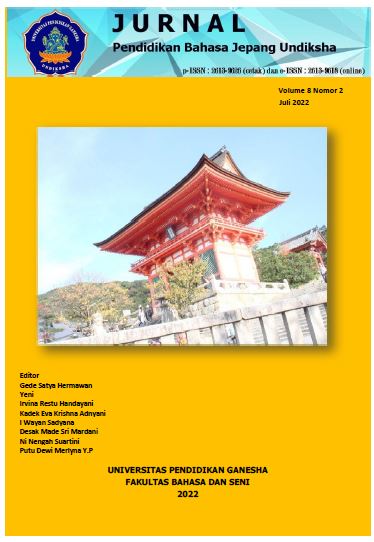MEDIA PEMBELAJARAN HURUF KATAKANA BERBASIS DARING DI SMKN 7 PEKANBARU
DOI:
https://doi.org/10.23887/jpbj.v8i2.44300Keywords:
Katakana, media pembelajaran, pembelajaran daringAbstract
Based on the results of the explanations that have been presented, it can be concluded that there are differences in learning Katakana letters offline and online at SMKN 7 Pekanbaru. This difference is found in the strategies and learning media used by the teacher. When offline, interactions between teachers and students occur face-to-face. Teachers tend to use discussion strategies and divide students into small groups because they are considered effective for use directly with students.
The teacher explains the material directly without having to feel rushed and think about the condition of the network. In online learning, teachers do not use strategies related to performance and small group activities. Teachers are more focused on providing material. When learning offline, the teacher has the flexibility to teach, while when learning online, there is limited time. Time systematic differences were also found between offline learning and online learning. The difference is that offline learning takes longer than online learning.
During online learning, the teacher uses PowerPoint Slides which contain learning materials and learning videos. Teachers also use other applications including Google Classroom as a medium for students to collect assignments and ask questions about assignments and Google Meet as a medium for virtual meetings with students.
The obstacles that occur in online learning at SMKN 7 Pekanbaru are the instability of the internet network causing the teaching and learning process to be disrupted, teachers' difficulty monitoring students, the difficulty of finding a conducive learning environment for students and there are some students who do not have devices for online learning.
References
A. Sadikin, H. Afreni, “Pembelajaran Daring di Tengah Wabah Covid-19”, Biodik : Jurnal Ilmiah Pendidikan Biologi, vol. 6, no. 2, pp. 214-224, 2020.
D. Istiqomah, L. Diner, and C. K. Wardhana, "Analisis Kesulitan Belajar Bahasa Jepang Siswa SMK Bagimu Negeriku Semarang, " Jurnal Chie, vol. 4, no. 1, pp. 319-563, 2015.
D. M. S, Mardani, 2012, “Pemanfaatan Media Visual untuk Meningkatkan Kemampuan Menulis Huruf Hiragana dan Katakana, Jurnal Pendidikan dan Pengajaran, vol. 45, no. 3, 2012.
D. Matsumoto, “Culture, context and behaviour”, Journal Personality, vol. 75, no. 6, pp. 1285-1320, 2007.
D. Sawitri, “Penggunaan Google Meet untuk Work From Home di Era Pandemi Corona Virus Disease 2019 (Covid-19)”, Jurnal Pengabdian Masyarakat, vol.2, no. 1, 2020.
N.P.M. Nandini, D. M. S. Mardani and G.S . Hermawan, G.S, “Profil Strategi Pembelajaran Bahasa Jepang di SMA Negeri 1 Ubud”, JPBJ: Jurnal Pendidikan Bahasa Jepang, vol. 5, no. 2, pp. 295-303, 2019.
R. M. Gagne, “Kondisi Belajar dan Teori Pembelajaran”, Jakarta: PAUD Dirjen Dikti Jakarta, 1989.
R. Supriani, and I. R. Siregar, 2012. "Penelitian Analisis Kesalahan Berbahasa”, Jurnal Edukasi Kultura: Jurnal Bahasa, Sastra dan Budaya, vol. 3, no. 2, 2012.
S. Arikunto, “Prosedur Penelitian”, Yogyakarta: Rineka Cipta, 2006.
S.D. Budiwati,J. Haryatno, and E.M. Dharma, “Japanese Character (Kana) Pattern Recognition Application Using Neural Network”, International Conference on Electrical Engineering and Informatics, 2011.
Sugiyono, “Metode Penelitian Pendidikan Pendekatan Kuantitatif, Kualitatif dan R&D”, Bandung: CV Alfabeta, 2015.
T. A. P. Dewi, and A. Sadjiarto, "Pelaksanaan Pembelajaran Daring pada Masa Pandemi Covid-19”, Jurnal Basicedu, vol. 5, no. 4 , pp.1909-1917, 2021.
W. A. F. Dewi, “Dampak COVID-19 terhadap Implementasi Pembelajaran Daring di Sekolah Dasar”, Edukatif : Jurnal Ilmu Pendidikan, vol. 2, no. 1, pp. 55–61, 2020.
World Health Organization, “WHO Coronavirus Disease (COVID-19) Dashboard”, Nov. 23, 2021 [online]. Available: https://covid19.who.int/table.
Downloads
Published
Issue
Section
License
Copyright (c) 2022 Jurnal Pendidikan Bahasa Jepang Undiksha

This work is licensed under a Creative Commons Attribution-ShareAlike 4.0 International License.



